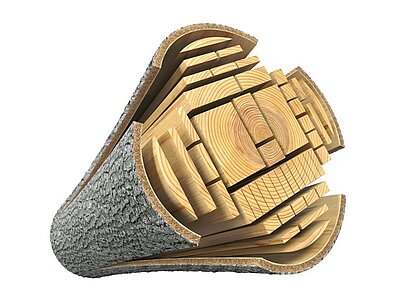General

Wood packaging material (packaging), hereinafter referred to as the LPM, is usually made from wood of lower quality which cannot be used in the production of quality wood products. The LPM is widely used in international transport and is carried from one country or continent to another. Consequently, it presents a risk for the introduction and spread of organisms harmful to plants. The risk may be even greater if the LPM is made from raw wood in the rough partly or totally stripped of bark.
The LPM used in transport must comply with the following technical requirements:
- It must be adequately heat treated (international treatment code HT) or heat treated using dielectric heating (international treatment code DH) or fumigated with methyl bromide (international treatment code MB);
- It must be officially marked with the ISPM-15 stamp;
- It must be made from debarked wood. Any number of visually separate and clearly distinct small pieces of bark may remain if they are less than 3 cm in width or greater than 3 cm in width with the total surface area of an individual piece of bark of less than 50 square cm (the approximate size of a credit card).
Other packaging material is that used in international transport to protect, attach, support or transport goods and is not considered to be wood packaging material. The following articles are regarded as other packaging material:
- paper products,
- wood products of 6 mm or less in thickness,
- barrels for wine and spirit that were heated during manufacture,
- gift boxes for wine, cigars and other commodities made from wood that has been processed in a way that renders it free of pests,
- sawdust, wood shavings and wood wool,
- wood components permanently attached to freight vehicles or containers,
- packaging material made wholly from processed wood material (e.g. plywood, particle board, oriented strand board or veneer) or created using glue, heat or pressure or treated according to officially approved procedures for destroying, removing or sterilising harmful organisms.
Customs authorities check the LPM during regular controls of the goods entering the customs territory of the EU and of the goods upon their release for free circulation. When customs authorities detect that a LPM shipment from a third country entering the customs territory of the EU or being released for free circulation does not comply with the prescribed phytosanitary requirements or shows signs of harmful organisms, they prohibit the entry of the LPM into the territory of the EU or its release for free circulation. They inform the locally competent office of the Administration of the Republic of Slovenia for Food Safety, Veterinary and Plant Protection (hereinafter referred to as UVHVVR). Such shipment may be assigned to a customs approved treatment or use only on the basis of the approval granted by a competent UVHVVR inspector.
When importing the LPM to Europe, there are some exceptions. The following shipments shall not be rejected or subject to any measures until further notice:
- wood packaging material not intended to support the freight (e.g. pallets);
- fuel wood supported with load boards (the entire shipment is intended to be used as fuel);
- dunnage used to support a shipment of other wood (e.g. timber wood) provided that it is of the same type and quality and that it complies with the same phytosanitary requirements as the wood contained in the shipment;
- fruit and vegetables wooden crates (despite the fact that the corners of the crates are greater than 6 mm in thickness)
Legislation
EU legislation
Directives
- Council Directive 2000/29/EC of 8 May 2000 on protective measures against the introduction into the Community of organisms harmful to plants or plant products and against their spread within the Community
 REPUBLIC OF SLOVENIA
REPUBLIC OF SLOVENIA